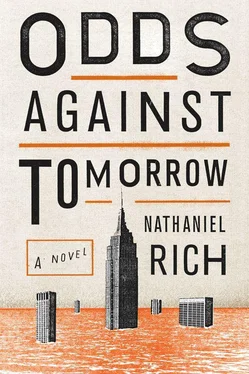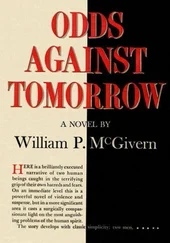Then he saw the reason. The Psycho had drifted past the kiosk, and the western staircase had begun to emerge from the blackness. The tunnel between the twin marble staircases was like a large, greedy mouth drinking the water. But clogging that mouth, and against the bottom of the stairs, were bodies. Not just one or two, as he thought he might have glimpsed on Third Avenue, but at least fifteen, maybe twenty, and the number kept getting larger the closer he got. He began to make out bare arms and legs and gray, puffy faces. It was as if they had been stacked there on purpose. And then came the smell — a sour, mildewed ghastliness. Mitchell backpaddled, hard, and the boat rocked. Jane shifted but did not open her eyes.
And the horror pounced on him, the roaches scrambling in his stomach, the panic sharp, cutting off his breath — he could see it all now, the waves rushing in from the East River, the water rising more quickly than anyone could imagine, surging through the Lexington Avenue entrances and down the long halls into the concourse. There must have been dozens, maybe hundreds of people in the terminal then, standing or sitting on the floor of the concourse, seeking shelter from the storm and waiting until the trains started running again. When the water began seeping into the station those people would have known better than to head down the ramps to the underground train tracks. Most likely they raced up the stairs, some of them abandoning their luggage, and ran out toward Vanderbuilt Avenue.
A second group of people would have been on the lower level, sitting in the open train cars, maybe lying across the seats, naively hoping to be on the first train out, once service was continued. As the water started rising in the tunnel, some of the people on the trains — the New Yorkers, the daily commuters — would have known to run out to the concourse and up the stairs, and they too would have escaped to higher ground.
But a third group, whether out of ignorance or pure panic, would have stayed put. That, after all, was the natural human response to disaster. Psychologists called it the incredulity response, or normalcy bias: most people, having never experienced a real catastrophe firsthand, don’t actually believe their eyes. This is why some pleasure cruisers don’t leave their cabins even as their ship is sinking, why some office workers continue sending e-mails even after they’ve learned that, on a lower floor, their building is on fire, why a stunningly high percentage of people who die in skydiving accidents are found to have never pulled the backup parachute line. The people waiting in the trains needn’t have waited very long. In the tunnels the pipes would have soon burst, and with the pumps overwhelmed, the water would have risen quickly from the ground. The whole thing might have been inundated within ninety seconds. Those people would still be there this minute, entombed in the submerged trains.
Yet there was also a final category of people: those who waited in the trains until it was almost too late, and then, rather than limply succumbing to their watery fate, came to their senses and ran out of the tunnel just in time. These people would’ve had to work hard, racing up the ramps against the cascading water — it would have been like running up a waterfall — only to reach the concourse. But by then the terminal would have been like the ocean, for in the first stage of flooding the water was undoubtedly deep and turbulent, gushing in from several directions, seeping up from the tunnels and in waves from Lexington Avenue. The floodwaters would have lifted the desperate people off their feet and swept them toward the western end of the concourse, as if the flood wanted to nudge them toward safety but didn’t know its own strength, until finally it crashed their bodies against the marble staircase. And so they would rest there, in a grotesque human dam, until the water subsided and the rescue crews arrived.
Mitchell didn’t wake Jane until they were back on Lexington Avenue.
“Why are you breathing like that?” she said.
“Like what?” he said, and they were under the real sky again, blinking in the sunlight.
4.
On Forty-fifth Street and Lexington a man was wailing. The noise seemed to be coming from an old tenement building that was barely standing; it leaned into the street at a cockeyed angle. They gave it a wide berth. On Forty-fifth and Third a woman was barking gibberish: “ Ungh. Ronned. Shmoft. ” And on a fire escape off Forty-fifth and Second a man was preaching to the sky, a waterlogged copy of the Bible bloating in his hands like a sea sponge. “Alas, that great city! God hath remembered her iniquities . In one hour so great riches is come to nought!”
They saw things they instantly tried to forget. The swollen corpse of a tabby cat, its head unnaturally inclined; doggy-paddling rats; a child’s coloring book, the bleeding ink turning the water different colors; a red sports bra. On Forty-sixth and Second, a brownstone had capsized, effectively damming the street with brick sections of wall and squat sandstone plinths. The rooms were completely bare inside; even the wallpaper in some places had been torn off by the wind. And once in a while they saw bodies. These tended to gather at street corners and beneath the parked cars. They were all half submerged, limbs sprawled and distended. Many were naked, their clothes having been torn off by the force of the flood.
“I can’t,” said Jane. “Oh, help us. Please help us.”
“Don’t look. I’ll do the looking. I’ll steer. Just paddle.”
It was not always possible to avoid looking. They passed very close to an old woman, a young man, another woman. But they rarely saw the faces. By some compassionate force of nature the drowned bodies floated facedown.
If they didn’t name what they saw, the things maintained an unreality. But just say the words “drowned cat” and, like a witch uttering abracadabra, the bloated belly, matted brown fur, twisted mouth, grasping paw, eyes watery with terror — the drowned cat appeared in their canoe, a third passenger, never to disappear. So they limited their conversation to canoeing directions, calling out debris and other obstacles. Almost immediately Jane had settled upon a simple code. Whenever they encountered a hunk of machinery, personal item, or a formerly living thing, she simply called out “flotsam” or “big flotsam”—or, in the case of the capsized brownstone, “really big flotsam”—and left it at that. Jane had become almost cartoonishly playful, as if determined to transform their journey into some kind of awful game. At first Mitchell was bothered by such blatant self-delusion. But as time elapsed and the fog held steady, he started to appreciate the tactic. It reflected one of the qualities that had made Jane so good at her job: she was a genius at beating back denial, at making improbable scenarios seem likely to occur. One of her favorite rhetorical tricks in consultation meetings had been to point out that an event that happens once every thousand days occurs on average, according to the math of probability, every two years. As it turned out, Jane was equally persuasive in making the case for denial. If Mitchell stared at the back of her head and avoided looking at the water, he could almost convince himself that he was back on Little Elkhart Lake, where the only obstacles he had to avoid were boulders and floating branches.
He wondered whether Elsa was dead.
About ten blocks ahead First Avenue passed through a short tunnel under the Queensboro Bridge. Since there was not much room between the surface of the water and the tunnel ceiling and Mitchell did not particularly relish the idea of canoeing through a dark cave, especially when the water level might suddenly rise at any moment, he hooked east, to Sutton Place. They’d have to veer even closer to the East River, but that seemed safer than heading west, back to Babylon.
Читать дальше












